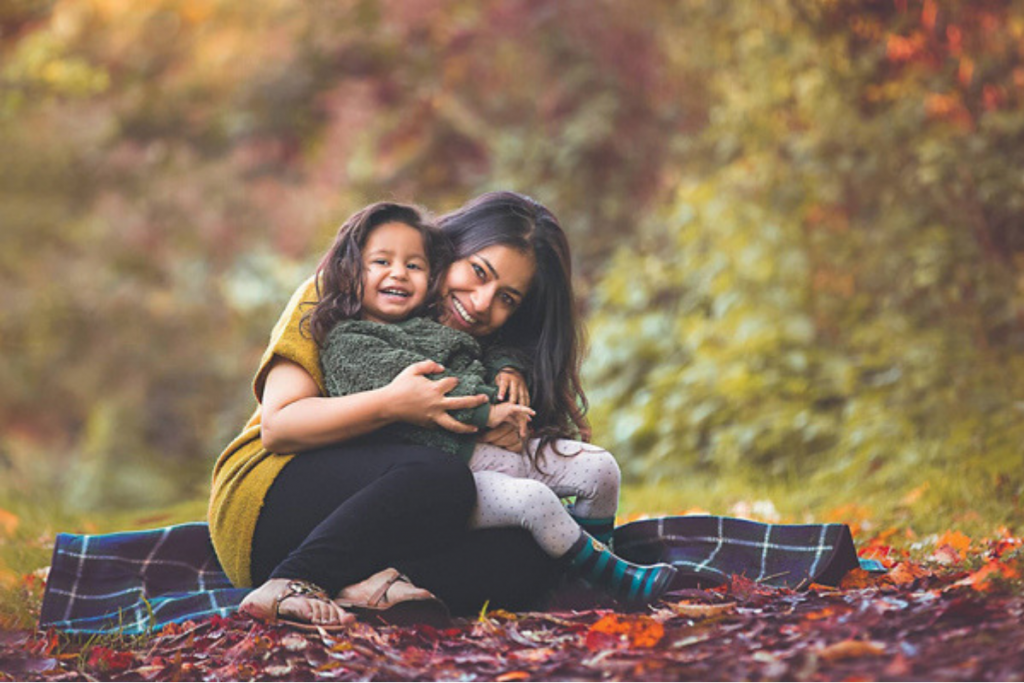Before you start working for others, work
Sujata Setis
for yourself and on yourself
Based in UK, London, Sujata Setia, is a multi-award winning photographer. Sujata has received immense recognition for her impeccable and out-of-the-box photography. Hereí s a tete-e-tete with this incredible Indian origin photographer.
How did your interest in natural and family photography develop? Please tell us about your journey.
Photography almost fell into my lap. I was a radio jockey back in India and moved to the UK (10 years ago) after marriage. Here, I struggled for five years to find a job (which never came through as my qualifications in India held no value here) and somewhere within me a loss of confidence started to make home. I felt lost and confused and the only way I could express myself and my battle with depression was via a visual/creative medium. Thankfully at some point my husband had gifted me a camera and I started to photograph my seven month old daughter with it. I believe, it is here that my interest in photography developed. There’s one thing I have realised over these years of dealing with my internal demons that I had nothing to lose. Life had given me this incredible blessing in the form of my ability to be creative so I decided to make the most of it and started offering photo shoots to my friends and family to build my portfolio. Once I did that, there was no looking back. Onwards and upwards!
Your photographs are unusual and unique, please discuss about your vision of photography.
Photography has been my way of overcoming my internal demons. It has been my medicine, my blessings, and my only voice. And it is through photography that I express my life’s entire journey. What you see there is what the narrative of my life is. I started this journey by expressing the beautiful relationship my daughter shared with my dog (son) – Mustang. When we lost Mustang suddenly one day, I tried to overcome that loss by photographing other babies and animals and hence created a series with newborn babies and newborn animals/birds images. My next project was a series of images of mothers, holding their babies in a natural setting, and that came from me wanting to recreate the beautiful relationship I shared with my daughter just when she was born (as I was never really able to chronicle that relationship since I wasn’t doing photography back them.) My latest series of grandparents and grandchildren came from the need for me to overcome the loss of my own grandmother. For me photography has been my triumph! Triumph over setbacks, over battlesÖ over the challenges life has thrown at me. It’s my way of smiling back at life and saying ‘Thank you. It has all been incredibly beautiful so far’.

How do you decide your concepts? What inspires you?
Life inspires me. Fearlessness inspires me and so I photograph children and elderlies often; anywhere between those two ages, we are just so damn scared of everything in this world. What will the neighbours think of me? What will the woman sitting next to me in the train think of me? What will the boss think? As adults we are just so scared to live.
For concepts, I look around and extract narratives from my own childhood and that of my daughter’s and then transpire it into my images. The first step to creating a great concept is to write down on a piece of paper, what story you want to narrate. I always come up with a storyline. Then I write a small caption to go with that story and based on the emotion that caption holds, I select my models, location and light of the day. The final image then just follows. For example, for the grandfather giving a flower to the grandma images where it said ìCan you lend me just another lifetime? So I can make up for the days I forgot to make you laugh!î It was the caption I wrote first before I shot the image. That just helped me know very clearly what emotion I wanted to focus on in the visual narrative.
Please tell us about the series you recently posted on social media, photography of old and young generations together.
This series came as a result of me wanting to recreate my childhood and my time spent with my own maternal grandma and my paternal grandpa. They were the two loves of my life. I started creating this series as an ode to those times spent together.
How did you find your signature style and your advice to those looking for their own?
I do a lot of personal work. For me photography is like bringing up a child. I not just do this work as a profession; I also focus a lot on doing my personal project, which I do just for myself and not for the purpose of making money. That is where I started developing my style from. Because when you do your personal projects, you don’t have the pressure of delivering anything to the clients as per their needs. Everything is your own. It is your story, your choice of models, your choice of clothing and so whatever comes off that personal project will be 100 percent yours. That’s the place where ‘personal style’ starts to take shape. And that would be my advice to everyone looking for their ‘style’. Before you start working for others, work for yourself and on yourself!
How do you plan your shoots, is the concept decided on the spot or do you plan it prior to the shoot?
My concepts are never ad hoc. I always write down my shots on a piece of paper beforehand. Then I go to the location a day in advance to create a practice version of those shots and then on the actual day of the shoot I recreate them again. This helps me make sure that I am leaving no place for error because truly, magic is not coincidence. It is never coincidence, magic is calculated risk!

Do you feel you have evolved as a photographer?
Yes
What latest equipments do you use for the photo shoots?
My main camera body is Nikon D800 and I use several lenses including 70-200 f 2.8, 135mm f2DC, 85mm f1.4, 50mm f1.4, 35mm f.14
How can one tell a story in images?
By actually feeling it first. If it is your own story and not something you are copy pasting from someone else’s work, then it will be incredibly simple for you to narrate it in images. Empathy is the most essential skill set any storytelling photographer must have.
Toddlers are difficult to deal with during photo shoots, how do you manage the situation?
I’ve always told my students that children have a limit of maximum 45 minutes to withstand a shoot and that’s the time I take maximum photographs with them. It is important to have them well fed, well slept and in close proximity to their mothers so that you are able to photograph them. Without these three requirements fulfilled, toddlers don’t enjoy the photo session and it is important that they enjoy what they are doing.
What is a perfect picture according to you?
There is nothing such as a ‘perfect picture’. It is an art form, a feeling and feelings are incredibly subjective to be put into boxes of ‘perfection’.
Some tips for the beginners
Be fearless, experiment with your art, do not fear investing in learning from someone you admire and spend time creating images just for your creative satisfaction.
Your favourite photographer
Steve Mccurry
Your most memorable photoshoot experience so far and your favourite clients.
All my shoots are special. I get to hear so many beautiful stories every single time. Just a week ago I photographed this beautiful elderly couple by the beach in Ireland. Their son told me later (after the shoot got over) that they had sold their home 15 years ago and have ever since then been travelling the world together in a camper van and wherever they go, even today, they hold hands. I loved photographing them.
What is your philosophy of life?
Only focus on what’s beautiful.

